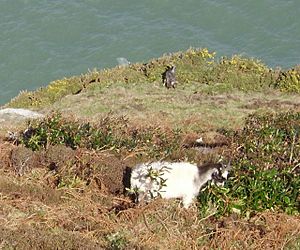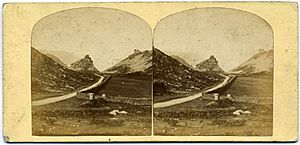Valley of Rocks facts for kids

The Valley of Rocks is a unique valley in north Devon, England. It's about 1 kilometer (0.6 miles) west of the village of Lynton. This valley is special because it runs right next to the coast. It's a popular place for visitors, known for its amazing landscape, interesting rocks, and a group of feral (wild) goats that live there.
Contents
Amazing Rocks and How the Valley Formed
The Valley of Rocks shows off some of the oldest rocks in north Devon. These rocks are called the Lynton Beds. They formed during the Devonian period, which was about 419 to 359 million years ago! You can find many fossils in these rocks, which are the remains of ancient life.
How the Valley Was Created
This valley also has cool features from the last Ice Age. During that time, this area was at the edge of a huge ice sheet. Scientists believe the valley was once part of a longer river valley. This river, the East Lyn River, now meets the sea at Lynmouth. Over time, the ocean's waves slowly wore away the cliffs, a process called coastal erosion. This erosion cut off the old river valley, leaving behind the dry Valley of Rocks we see today.
Famous Visitors and Their Stories
The beautiful and dramatic scenery of the Valley of Rocks has inspired many famous writers and musicians.
Writers and Poets
In 1797, two famous poets, Samuel Taylor Coleridge and William Wordsworth, visited the valley together. They were so inspired that they planned to write a story called "The Wanderings of Cain," set right there. However, they never finished it.
Another poet, Robert Southey, visited in 1799. He was very impressed, describing the valley as "covered with huge stones." He said it looked like "the very bones and skeletons of the earth."
Later, in 1831, the poet Letitia Elizabeth Landon wrote a poem about the valley. She saw it as a place for unhappy thoughts, saying, "Gloomy vale! if thou couldst be haunt for human misery, half our life were spent with thee."
The famous author R. D. Blackmore also used the valley in his well-known novel, Lorna Doone. This book was first published in 1869.
Musical Inspiration
In 1974, an Australian composer named Miriam Hyde visited the area with her husband. She was so moved by the Valley of Rocks that she wrote a piano piece about it in 1975. This piece, also called Valley of Rocks, became her most famous musical work.




